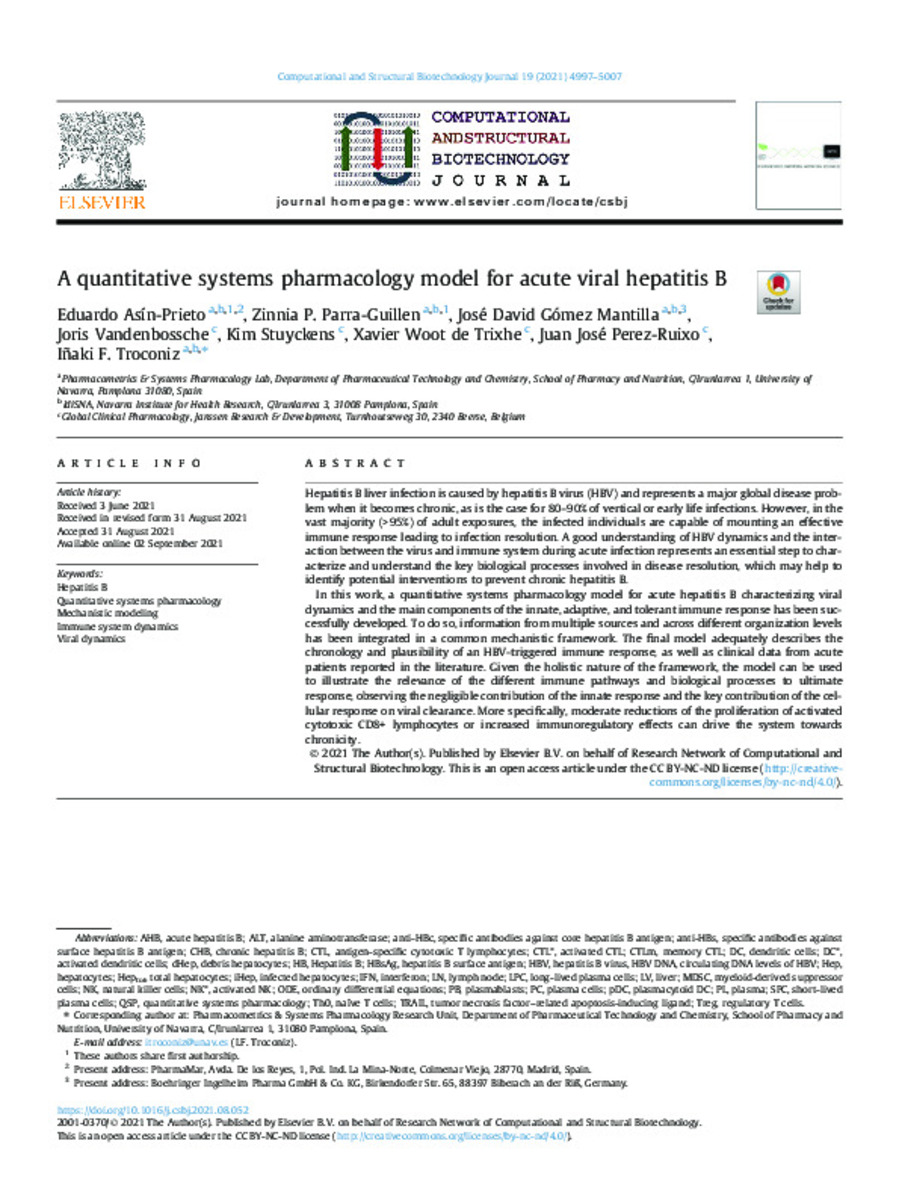Full metadata record
| DC Field | Value | Language |
|---|---|---|
| dc.creator | Fernández-de-Trocóniz, J.I. (José Ignacio) | - |
| dc.creator | Asín-Prieto, E. (Eduardo) | - |
| dc.creator | Parra-Guillen, Z.P. (Zinnia Patricia) | - |
| dc.creator | Gómez-Mantilla, J.D. (José David) | - |
| dc.creator | Vandenbossche, J. (Joris) | - |
| dc.creator | Stuyckens, K. (Kim) | - |
| dc.creator | De-Trixhe, X. (Xavier) | - |
| dc.creator | Pérez-Ruixo, J.J. (Juan José) | - |
| dc.date.accessioned | 2024-01-17T12:38:17Z | - |
| dc.date.available | 2024-01-17T12:38:17Z | - |
| dc.date.issued | 2021 | - |
| dc.identifier.citation | Fernández-de-Trocóniz, J.I. (José Ignacio); Asín-Prieto, E. (Eduardo); Parra-Guillen, Z.P. (Zinnia Patricia); et al. "A quantitative systems pharmacology model for acute viral hepatitis B". Computational and Structural Biotechnology Journal. 19, 2021, 4997 - 5007 | es_ES |
| dc.identifier.uri | https://hdl.handle.net/10171/68399 | - |
| dc.description.abstract | Hepatitis B liver infection is caused by hepatitis B virus (HBV) and represents a major global disease problem when it becomes chronic, as is the case for 80–90% of vertical or early life infections. However, in the vast majority (>95%) of adult exposures, the infected individuals are capable of mounting an effective immune response leading to infection resolution. A good understanding of HBV dynamics and the interaction between the virus and immune system during acute infection represents an essential step to characterize and understand the key biological processes involved in disease resolution, which may help to identify potential interventions to prevent chronic hepatitis B. In this work, a quantitative systems pharmacology model for acute hepatitis B characterizing viral dynamics and the main components of the innate, adaptive, and tolerant immune response has been successfully developed. To do so, information from multiple sources and across different organization levels has been integrated in a common mechanistic framework. The final model adequately describes the chronology and plausibility of an HBV-triggered immune response, as well as clinical data from acute patients reported in the literature. Given the holistic nature of the framework, the model can be used to illustrate the relevance of the different immune pathways and biological processes to ultimate response, observing the negligible contribution of the innate response and the key contribution of the cellular response on viral clearance. More specifically, moderate reductions of the proliferation of activated cytotoxic CD8+ lymphocytes or increased immunoregulatory effects can drive the system towards chronicity. | es_ES |
| dc.description.sponsorship | Janssen Research & Development | es_ES |
| dc.language.iso | eng | es_ES |
| dc.rights | info:eu-repo/semantics/openAccess | es_ES |
| dc.subject | Hepatitis B | es_ES |
| dc.subject | Quantitative systems pharmacology | es_ES |
| dc.subject | Mechanistic modeling | es_ES |
| dc.subject | Immune system dynamics | es_ES |
| dc.subject | Viral dynamics | es_ES |
| dc.title | A quantitative systems pharmacology model for acute viral hepatitis B | es_ES |
| dc.type | info:eu-repo/semantics/article | es_ES |
| dc.relation.publisherversion | https://www.sciencedirect.com/science/article/pii/S2001037021003834?via%3Dihub | es_ES |
| dadun.citation.endingPage | 5007 | es_ES |
| dadun.citation.publicationName | Computational and Structural Biotechnology Journal | es_ES |
| dadun.citation.startingPage | 4997 | es_ES |
| dadun.citation.volume | 19 | es_ES |
Files in This Item:
Statistics and impact
Items in Dadun are protected by copyright, with all rights reserved, unless otherwise indicated.






